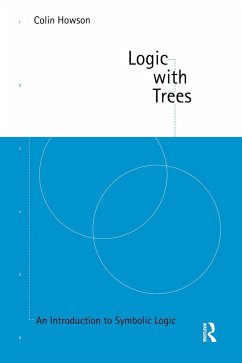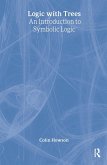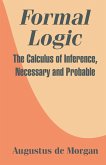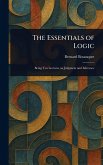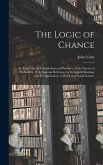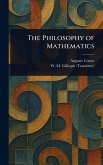- Broschiertes Buch
- Merkliste
- Auf die Merkliste
- Bewerten Bewerten
- Teilen
- Produkt teilen
- Produkterinnerung
- Produkterinnerung
First published in 1997. Routledge is an imprint of Taylor & Francis, an informa company.
Andere Kunden interessierten sich auch für
![Logic with Trees Logic with Trees]() Colin HowsonLogic with Trees183,99 €
Colin HowsonLogic with Trees183,99 €![Formal Logic Formal Logic]() Augustus De MorganFormal Logic20,99 €
Augustus De MorganFormal Logic20,99 €![The Essentials of Logic The Essentials of Logic]() Bernard BosanquetThe Essentials of Logic29,99 €
Bernard BosanquetThe Essentials of Logic29,99 €![The Logic of Chance The Logic of Chance]() John VennThe Logic of Chance38,99 €
John VennThe Logic of Chance38,99 €![Logic; Volume 2 Logic; Volume 2]() Christoph SigwartLogic; Volume 242,99 €
Christoph SigwartLogic; Volume 242,99 €![The Philosophy of Mathematics The Philosophy of Mathematics]() Auguste ComteThe Philosophy of Mathematics30,99 €
Auguste ComteThe Philosophy of Mathematics30,99 €![Principia Mathematica; Volume 2 Principia Mathematica; Volume 2]() Alfred North WhiteheadPrincipia Mathematica; Volume 247,99 €
Alfred North WhiteheadPrincipia Mathematica; Volume 247,99 €-
-
-
First published in 1997. Routledge is an imprint of Taylor & Francis, an informa company.
Produktdetails
- Produktdetails
- Verlag: Routledge
- Seitenzahl: 212
- Erscheinungstermin: 27. Februar 1997
- Englisch
- Abmessung: 234mm x 156mm x 12mm
- Gewicht: 330g
- ISBN-13: 9780415133425
- ISBN-10: 0415133424
- Artikelnr.: 21593623
- Herstellerkennzeichnung
- Libri GmbH
- Europaallee 1
- 36244 Bad Hersfeld
- gpsr@libri.de
- Verlag: Routledge
- Seitenzahl: 212
- Erscheinungstermin: 27. Februar 1997
- Englisch
- Abmessung: 234mm x 156mm x 12mm
- Gewicht: 330g
- ISBN-13: 9780415133425
- ISBN-10: 0415133424
- Artikelnr.: 21593623
- Herstellerkennzeichnung
- Libri GmbH
- Europaallee 1
- 36244 Bad Hersfeld
- gpsr@libri.de
Howson, Colin
Introduction. Part 1: Truth-Functional Logic Chapter 1. The Basics 1.
Deductively Valid Inference 2. Syntax: Connectives and the Principle of
Composition 3. Semantics: Truth-Functionality 4. Negation and Conjunction
5. Disjunction 6. Truth-Functional Equivalence 7. The Conditional 8. Some
Other Connectives, and the Biconditional Chapter 2. Truth Trees 1.
Truth-Functionally Valid Inference 2. Conjugate Tree Diagrams 3. Truth
Trees 4. Tautologies and Contradictions Chapter 3. Propositional Languages
1. Propositional Languages 2. Object Language and Metalanguage 3. Ancestral
Trees 4. An Induction Principle 5. Multiple Conjunctions and Disjunctions
6. The Disjunctive Normal Form Theorem 7. Adequate Sets of Connectives 8.
The Duality Principle 9. Conjunctive Normal Forms Chapter 4. Soundness and
Completeness 1. The Standard Propositional Language 2. Truth Trees Again 3.
Truth-Functional Consistency, Truth-Functionally Valid Inferences, and
Trees 4. Soundness and Completeness Part 2: First Order Logic Chapter 5.
Introduction 1. Some Non-Truth-Functional Inferences 2. Quantifiers and
Variables 3. Relations 4. Formalising English Sentences Chapter 6. First
Languages: Syntax and Two More Trees Rules 1. First Order Languages 2. Two
More Tree Rules 3. Tree Proofs Chapter 7. First Order Languages: Semantics
1. Interpretations 2. Formulas and Truth 3. The Tree Rules Revisited 4.
Consistency and Validity 5. Logical Truth and Logical Equivalence Chapter
8. Soundness and Completeness 1. Applying the Tree Rules 2. Branch Models
3. Soundness and Completeness Theorems 4. Compactness Chapter 9. Identity
1. Identity 2. Tree Rules For Identity 3. Some Arithmetic 4. Functions and
Function Symbols 5. Working with Equations 6. Is Identity Part of Logic?
Chapter 10. Alternative Deductive Systems for First Order Logic 1.
Introduction 2. H 3 ND 4. Comparisons 5. Intuitionism Chapter 11. First
Order Theories 1. First Order Theories 2. Infinite Cardinals 3.
Lowenheim-Skolem Theorems 4. Second O
Deductively Valid Inference 2. Syntax: Connectives and the Principle of
Composition 3. Semantics: Truth-Functionality 4. Negation and Conjunction
5. Disjunction 6. Truth-Functional Equivalence 7. The Conditional 8. Some
Other Connectives, and the Biconditional Chapter 2. Truth Trees 1.
Truth-Functionally Valid Inference 2. Conjugate Tree Diagrams 3. Truth
Trees 4. Tautologies and Contradictions Chapter 3. Propositional Languages
1. Propositional Languages 2. Object Language and Metalanguage 3. Ancestral
Trees 4. An Induction Principle 5. Multiple Conjunctions and Disjunctions
6. The Disjunctive Normal Form Theorem 7. Adequate Sets of Connectives 8.
The Duality Principle 9. Conjunctive Normal Forms Chapter 4. Soundness and
Completeness 1. The Standard Propositional Language 2. Truth Trees Again 3.
Truth-Functional Consistency, Truth-Functionally Valid Inferences, and
Trees 4. Soundness and Completeness Part 2: First Order Logic Chapter 5.
Introduction 1. Some Non-Truth-Functional Inferences 2. Quantifiers and
Variables 3. Relations 4. Formalising English Sentences Chapter 6. First
Languages: Syntax and Two More Trees Rules 1. First Order Languages 2. Two
More Tree Rules 3. Tree Proofs Chapter 7. First Order Languages: Semantics
1. Interpretations 2. Formulas and Truth 3. The Tree Rules Revisited 4.
Consistency and Validity 5. Logical Truth and Logical Equivalence Chapter
8. Soundness and Completeness 1. Applying the Tree Rules 2. Branch Models
3. Soundness and Completeness Theorems 4. Compactness Chapter 9. Identity
1. Identity 2. Tree Rules For Identity 3. Some Arithmetic 4. Functions and
Function Symbols 5. Working with Equations 6. Is Identity Part of Logic?
Chapter 10. Alternative Deductive Systems for First Order Logic 1.
Introduction 2. H 3 ND 4. Comparisons 5. Intuitionism Chapter 11. First
Order Theories 1. First Order Theories 2. Infinite Cardinals 3.
Lowenheim-Skolem Theorems 4. Second O
Introduction. Part 1: Truth-Functional Logic Chapter 1. The Basics 1.
Deductively Valid Inference 2. Syntax: Connectives and the Principle of
Composition 3. Semantics: Truth-Functionality 4. Negation and Conjunction
5. Disjunction 6. Truth-Functional Equivalence 7. The Conditional 8. Some
Other Connectives, and the Biconditional Chapter 2. Truth Trees 1.
Truth-Functionally Valid Inference 2. Conjugate Tree Diagrams 3. Truth
Trees 4. Tautologies and Contradictions Chapter 3. Propositional Languages
1. Propositional Languages 2. Object Language and Metalanguage 3. Ancestral
Trees 4. An Induction Principle 5. Multiple Conjunctions and Disjunctions
6. The Disjunctive Normal Form Theorem 7. Adequate Sets of Connectives 8.
The Duality Principle 9. Conjunctive Normal Forms Chapter 4. Soundness and
Completeness 1. The Standard Propositional Language 2. Truth Trees Again 3.
Truth-Functional Consistency, Truth-Functionally Valid Inferences, and
Trees 4. Soundness and Completeness Part 2: First Order Logic Chapter 5.
Introduction 1. Some Non-Truth-Functional Inferences 2. Quantifiers and
Variables 3. Relations 4. Formalising English Sentences Chapter 6. First
Languages: Syntax and Two More Trees Rules 1. First Order Languages 2. Two
More Tree Rules 3. Tree Proofs Chapter 7. First Order Languages: Semantics
1. Interpretations 2. Formulas and Truth 3. The Tree Rules Revisited 4.
Consistency and Validity 5. Logical Truth and Logical Equivalence Chapter
8. Soundness and Completeness 1. Applying the Tree Rules 2. Branch Models
3. Soundness and Completeness Theorems 4. Compactness Chapter 9. Identity
1. Identity 2. Tree Rules For Identity 3. Some Arithmetic 4. Functions and
Function Symbols 5. Working with Equations 6. Is Identity Part of Logic?
Chapter 10. Alternative Deductive Systems for First Order Logic 1.
Introduction 2. H 3 ND 4. Comparisons 5. Intuitionism Chapter 11. First
Order Theories 1. First Order Theories 2. Infinite Cardinals 3.
Lowenheim-Skolem Theorems 4. Second O
Deductively Valid Inference 2. Syntax: Connectives and the Principle of
Composition 3. Semantics: Truth-Functionality 4. Negation and Conjunction
5. Disjunction 6. Truth-Functional Equivalence 7. The Conditional 8. Some
Other Connectives, and the Biconditional Chapter 2. Truth Trees 1.
Truth-Functionally Valid Inference 2. Conjugate Tree Diagrams 3. Truth
Trees 4. Tautologies and Contradictions Chapter 3. Propositional Languages
1. Propositional Languages 2. Object Language and Metalanguage 3. Ancestral
Trees 4. An Induction Principle 5. Multiple Conjunctions and Disjunctions
6. The Disjunctive Normal Form Theorem 7. Adequate Sets of Connectives 8.
The Duality Principle 9. Conjunctive Normal Forms Chapter 4. Soundness and
Completeness 1. The Standard Propositional Language 2. Truth Trees Again 3.
Truth-Functional Consistency, Truth-Functionally Valid Inferences, and
Trees 4. Soundness and Completeness Part 2: First Order Logic Chapter 5.
Introduction 1. Some Non-Truth-Functional Inferences 2. Quantifiers and
Variables 3. Relations 4. Formalising English Sentences Chapter 6. First
Languages: Syntax and Two More Trees Rules 1. First Order Languages 2. Two
More Tree Rules 3. Tree Proofs Chapter 7. First Order Languages: Semantics
1. Interpretations 2. Formulas and Truth 3. The Tree Rules Revisited 4.
Consistency and Validity 5. Logical Truth and Logical Equivalence Chapter
8. Soundness and Completeness 1. Applying the Tree Rules 2. Branch Models
3. Soundness and Completeness Theorems 4. Compactness Chapter 9. Identity
1. Identity 2. Tree Rules For Identity 3. Some Arithmetic 4. Functions and
Function Symbols 5. Working with Equations 6. Is Identity Part of Logic?
Chapter 10. Alternative Deductive Systems for First Order Logic 1.
Introduction 2. H 3 ND 4. Comparisons 5. Intuitionism Chapter 11. First
Order Theories 1. First Order Theories 2. Infinite Cardinals 3.
Lowenheim-Skolem Theorems 4. Second O

